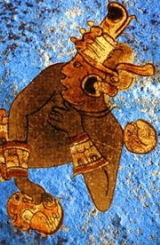
Maya Blue
Encyclopedia
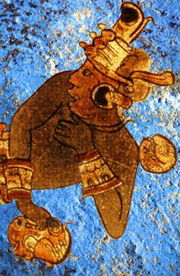
Azure (color)
The color bleu de France is displayed at right.Bleu de France is a color that has been associated in heraldry with the Kings of France since the 12th century.-Brandeis blue:...
pigment
Pigment
A pigment is a material that changes the color of reflected or transmitted light as the result of wavelength-selective absorption. This physical process differs from fluorescence, phosphorescence, and other forms of luminescence, in which a material emits light.Many materials selectively absorb...
manufactured by cultures of pre-Columbian
Pre-Columbian
The pre-Columbian era incorporates all period subdivisions in the history and prehistory of the Americas before the appearance of significant European influences on the American continents, spanning the time of the original settlement in the Upper Paleolithic period to European colonization during...
Mesoamerica
Mesoamerica
Mesoamerica is a region and culture area in the Americas, extending approximately from central Mexico to Belize, Guatemala, El Salvador, Honduras, Nicaragua, and Costa Rica, within which a number of pre-Columbian societies flourished before the Spanish colonization of the Americas in the 15th and...
, such as the Maya
Maya civilization
The Maya is a Mesoamerican civilization, noted for the only known fully developed written language of the pre-Columbian Americas, as well as for its art, architecture, and mathematical and astronomical systems. Initially established during the Pre-Classic period The Maya is a Mesoamerican...
and Aztec
Aztec
The Aztec people were certain ethnic groups of central Mexico, particularly those groups who spoke the Nahuatl language and who dominated large parts of Mesoamerica in the 14th, 15th and 16th centuries, a period referred to as the late post-classic period in Mesoamerican chronology.Aztec is the...
.
Manufacture
The Maya blue pigment is a composite of organic and inorganic constituents, primarily indigo dyeIndigo dye
Indigo dye is an organic compound with a distinctive blue color . Historically, indigo was a natural dye extracted from plants, and this process was important economically because blue dyes were once rare. Nearly all indigo dye produced today — several thousand tons each year — is synthetic...
s derived from the leaves of añil
Añil
Indigofera suffruticosa, commonly known as Anil, Guatemalan indigo, Small-leaved indigo , West Indian indigo, and Wild indigo, is a flowering plant in the pea family, Fabaceae...
(Indigofera suffruticosa) plants combined with palygorskite
Palygorskite
Palygorskite or attapulgite is a magnesium aluminium phyllosilicate with formula 2Si4O10·4 which occurs in a type of clay soil common to the Southeastern United States. It is one of the types of fuller's earth.-Name:...
, a natural clay. Smaller trace amounts of other mineral additives have also been identified.
Historical use
"Maya blue" first appeared around 800 and it was still used in the 16th century in several Convents of Colonial Mexico, notably in the paintings of the Indian Juan Gerson in Tecamachalco. These paintings are a clear example of the combination of Indian and European techniques sometimes known as Arte Indocristiano. After that, the techniques for its production were lost in Mexico but in Cuba there are examples from 1830.Resistance to weathering
Despite time and the harsh weathering conditions, paintings colored by Maya Blue have not faded over time. What is even more remarkable is that the color has resisted chemical solvents and acids such as nitric acid. Recently, its resistance against chemical aggression (acids, alkalis, solvents, etc.) and biodegradation was tested, and it was shown that Maya blue is an extremely resistant pigment, but it can be destroyed using very intense acid treatment under reflux.Research on chemical composition
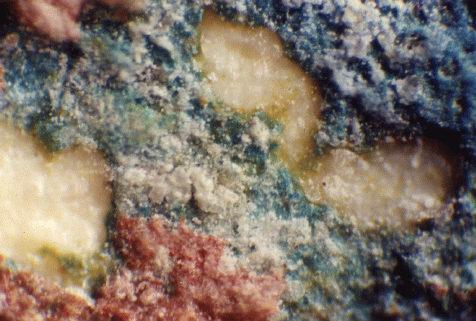
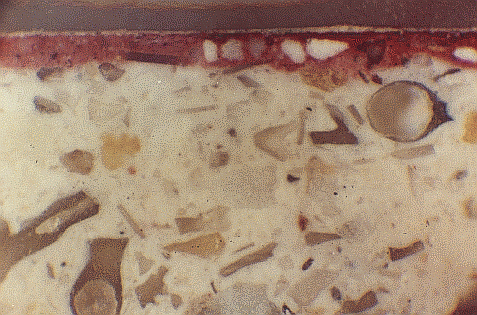
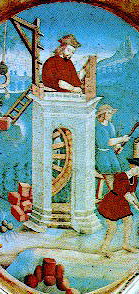
Powder diffraction
Powder diffraction is a scientific technique using X-ray, neutron, or electron diffraction on powder or microcrystalline samples for structural characterization of materials.-Explanation:...
in the 1950s and was found to be a composite of palygorskite
Palygorskite
Palygorskite or attapulgite is a magnesium aluminium phyllosilicate with formula 2Si4O10·4 which occurs in a type of clay soil common to the Southeastern United States. It is one of the types of fuller's earth.-Name:...
and indigo, most likely derived from the use of the leaves of the añil
Añil
Indigofera suffruticosa, commonly known as Anil, Guatemalan indigo, Small-leaved indigo , West Indian indigo, and Wild indigo, is a flowering plant in the pea family, Fabaceae...
. The actual recipe to reproduce Maya Blue pigment was published in 1993 by a Mexican historian and chemist, Constantino Reyes-Valerio
Constantino Reyes-Valerio
Constantino Reyes-Valerio was a prominent Mexican scholarof pre-Columbian Mesoamerican cultures, particularly the Aztec and the Maya as well as the Colonial Art....
. The combination of different of clays: palygorskite
Palygorskite
Palygorskite or attapulgite is a magnesium aluminium phyllosilicate with formula 2Si4O10·4 which occurs in a type of clay soil common to the Southeastern United States. It is one of the types of fuller's earth.-Name:...
, montmorillonite
Montmorillonite
Montmorillonite is a very soft phyllosilicate group of minerals that typically form in microscopic crystals, forming a clay. It is named after Montmorillon in France. Montmorillonite, a member of the smectite family, is a 2:1 clay, meaning that it has 2 tetrahedral sheets sandwiching a central...
, together with the use of the leaves of the añil
Añil
Indigofera suffruticosa, commonly known as Anil, Guatemalan indigo, Small-leaved indigo , West Indian indigo, and Wild indigo, is a flowering plant in the pea family, Fabaceae...
and the actual process is described in Reyes-Valerio (1993). Reyes-Valerio's contributions were possible due to his combined background of history and chemistry, through a thorough revision of primary texts (Sahagun, Hernandez. Jimenez and others), microscopic analysis of the mural paintings and Fourier Transform Infrared Spectroscopy.
After the formula for the production was published in the book "De Bonampak al Templo Mayor: Historia del Azul Maya en Mesoamerica" there were many developments in the chemical analysis of the pigment in collaborations between Reyes-Valerio with European Scientists..
A comprehensive study on the pigment which describes history, the experimental study techniques (Diffraction Studies, Infrared Spectroscopies, Raman, Optical Spectroscopies, Voltammetry, Nuclear Magnetic Resonance, Computer Modelling), the syntheses, properties and nature of maya blue and the research in relation with the Archaeological and Historical Contexts has been published in "Developments in Clay Science"
Uses in cultural contexts
Pre-Columbian American CulturePre-Columbian
The pre-Columbian era incorporates all period subdivisions in the history and prehistory of the Americas before the appearance of significant European influences on the American continents, spanning the time of the original settlement in the Upper Paleolithic period to European colonization during...
- In the continentContinentA continent is one of several very large landmasses on Earth. They are generally identified by convention rather than any strict criteria, with seven regions commonly regarded as continents—they are : Asia, Africa, North America, South America, Antarctica, Europe, and Australia.Plate tectonics is...
of AmericaAmericasThe Americas, or America , are lands in the Western hemisphere, also known as the New World. In English, the plural form the Americas is often used to refer to the landmasses of North America and South America with their associated islands and regions, while the singular form America is primarily...
, Maya blue was used as a colorant in pre-ColumbianPre-ColumbianThe pre-Columbian era incorporates all period subdivisions in the history and prehistory of the Americas before the appearance of significant European influences on the American continents, spanning the time of the original settlement in the Upper Paleolithic period to European colonization during...
artArtArt is the product or process of deliberately arranging items in a way that influences and affects one or more of the senses, emotions, and intellect....
works, sculptureSculptureSculpture is three-dimensional artwork created by shaping or combining hard materials—typically stone such as marble—or metal, glass, or wood. Softer materials can also be used, such as clay, textiles, plastics, polymers and softer metals...
s, muralMuralA mural is any piece of artwork painted or applied directly on a wall, ceiling or other large permanent surface. A particularly distinguishing characteristic of mural painting is that the architectural elements of the given space are harmoniously incorporated into the picture.-History:Murals of...
s, textiles (probably) and to illuminate Mesoamerican codices. Recent research also suggests that Maya blue may have played an important role in human sacrifices to ChaacChaacChaac is the name of the Maya rain deity. With his lightning axe, Chaac strikes the clouds and produces thunder and rain. Chaac corresponds to Tlaloc among the Aztecs.-Rain deities and rain makers:...
at Chichén ItzáChichen ItzaChichen Itza is a large pre-Columbian archaeological site built by the Maya civilization located in the northern center of the Yucatán Peninsula, in the Municipality of Tinúm, Yucatán state, present-day Mexico....
, both produced at the sacrificial site and used to paint the bodies of the victims.
See also
- Other classic artificial blue pigments: Egyptian BlueEgyptian BlueEgyptian blue is chemically known as calcium copper silicate . It is a pigment used by Egyptians for thousands of years. It is considered to be the first synthetic pigment. The pigment was known to the Romans by the name caeruleum...
, Chinese Blue - List of colors
External links
- Azul Maya, descriptive site by Reyes-Valerio

